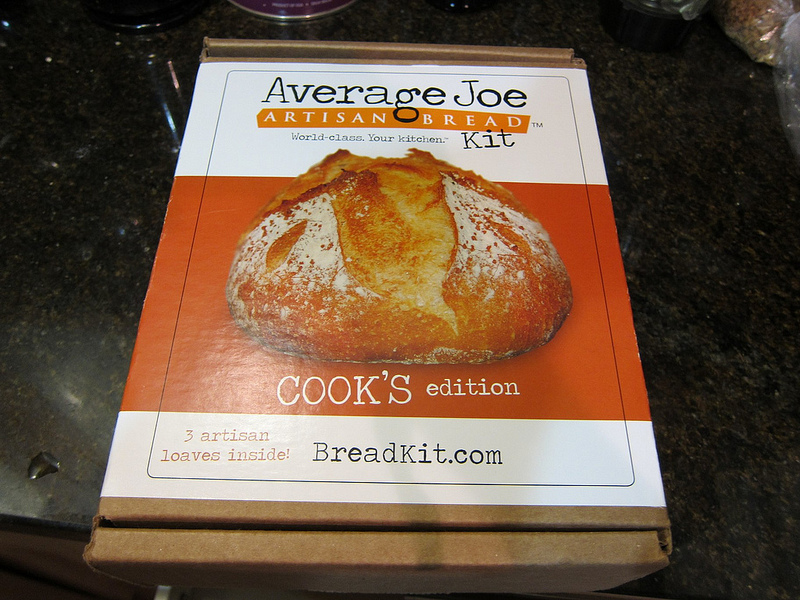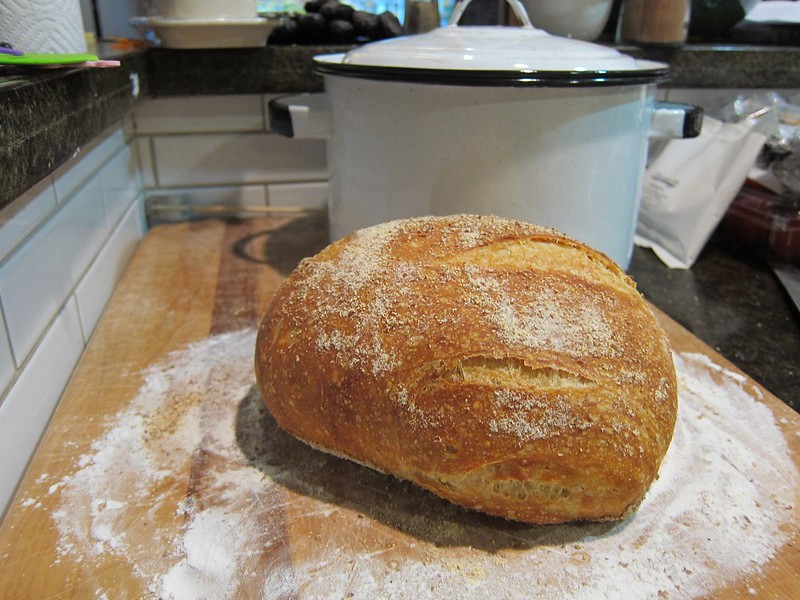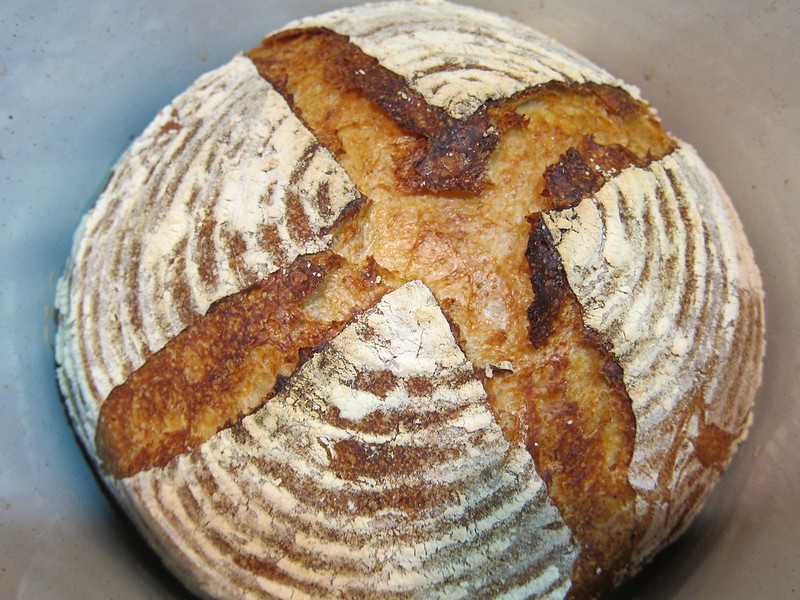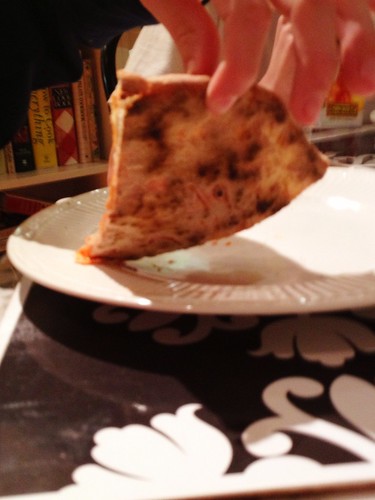
After the difficult and tedious Not So Stollen bake earlier in the week, we decide to continue our Thanksgiving bake list with something much simpler, less stressful even if not as enjoyable.
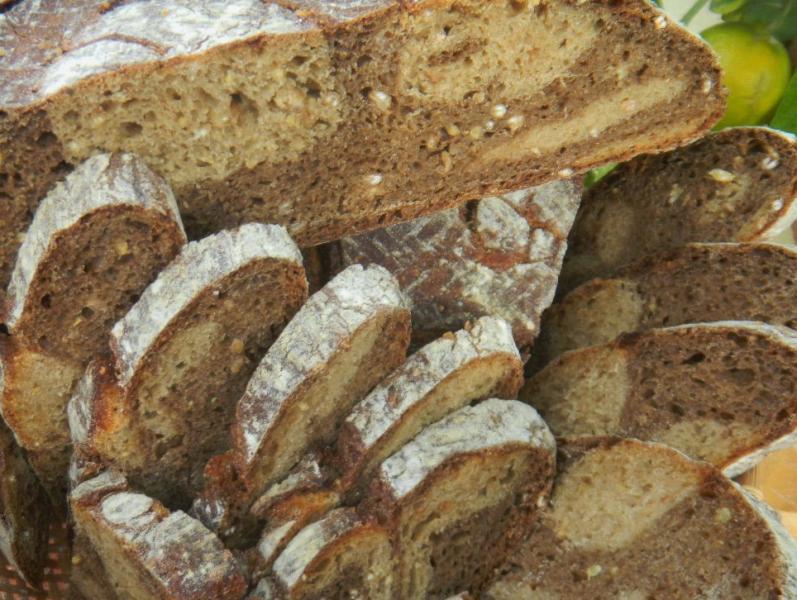


After seeing Toady Tom’s fantastic large miche bake and the excellent crust he managed to put on it, we decided to do a large loaf too only using the chacon shape we love to make since it too can produce a beautiful crust if it naturally splits where we would like as it springs and blooms in the oven heat.


We also wanted to try out a toasted wheat germ, soft white wheat extract and oat bran component similar to Toad’s to see what it tasted and looked like in the chacon. All but 10g went into the dark side.

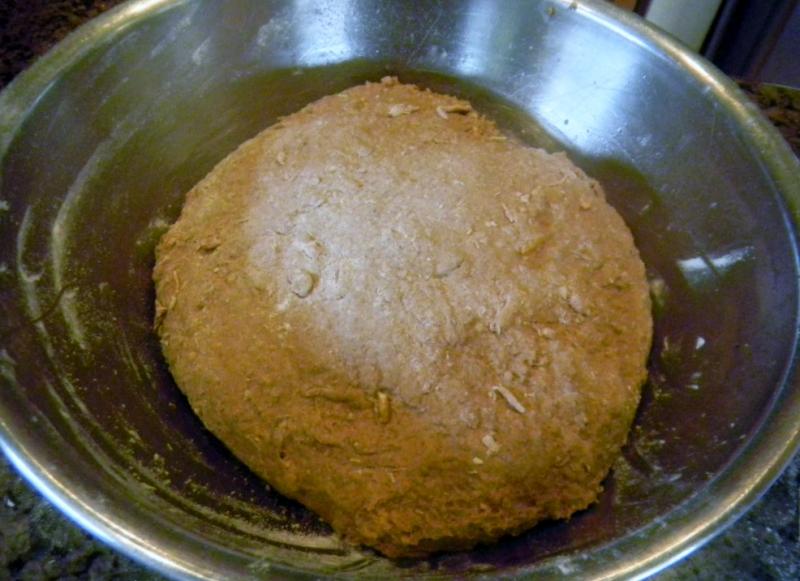
Instead of using our recent 1 starter and 24 hour counter levain development we went back to our roughly 20% seed levain for the SD starter required for this bake. One levain was Rye Desem combo SD for the heartier darker portion of the loaf that has 2all of the whole grains listed for the starter.

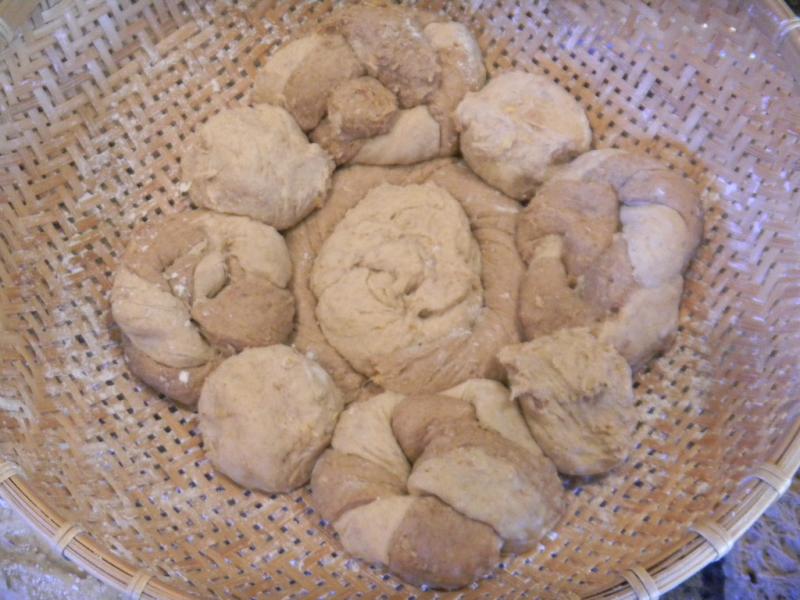
The other levain was a YW one that was fed with cake meal, another new ingredient for bread making for us. Many folks use this ground matzo altus for their lemon, poppy seed walnut cakes or possibly a chiffon cake of any number of possible flavors. We decided to try it out in the whiter portion of this bread only to see what it tasted like and how it performed in two different kinds of bread.
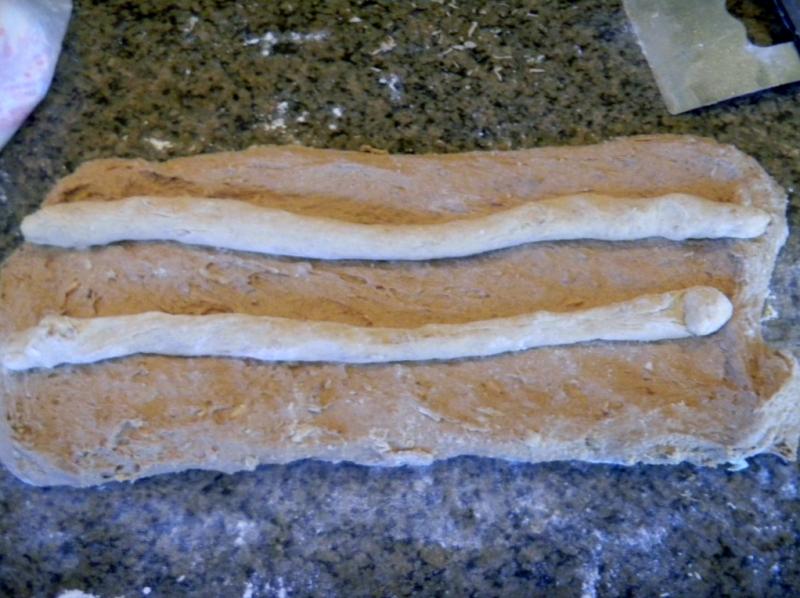
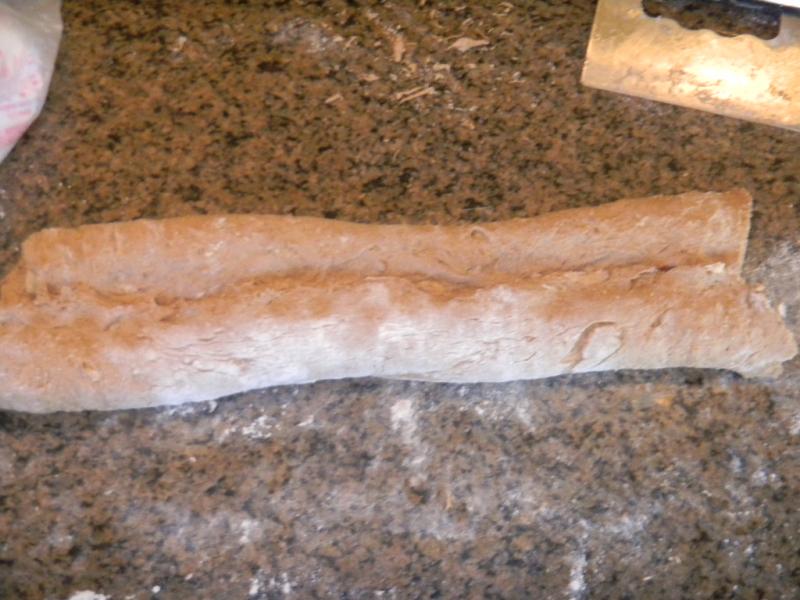
The instant coffee and the cocoa were only used in the dark portion to, you guessed it, make it darker than the light colored portion. We also used some yogurt whey water for some of the liquid in both portions with 2/3rds of it going into the dark side. The sprouts were also split between the two sides in the same proportion as the whey water - 2/3rds to the dark.


In order to finish the breakout, the white portion ended up being 500 g with 100 g of the AP and bread flour and 80 g of the whole grains in the bread flour and 10g of the toasted bits. Total flour and toasted stuff was 290 g and the liquid was 210 g (42 g whey) for a little over 72.4% hydration not counting any of the 1/3 of the sprout total that went into it.


With the malts, oats, and potato flakes on in the dark side the hydration of it was 82%.

The fun part was putting together the largest chacon we have ever made. The center knotted roll is made from the light side and the side going down into the basket is sprinkled with rice flour. It was surrounded by a twisted rope from the dark side. The 4 other knotted rolls, on the cardinal direction points, were made from equal portions of dark and light that were ropes twisted together to make one rope. The 4 little balls between the 4 twisted knotted rolls were from the light side. Remember to rice flour anything that will touch the basket so it doesn't stick - and don't rice flour anything else so it sticks together.
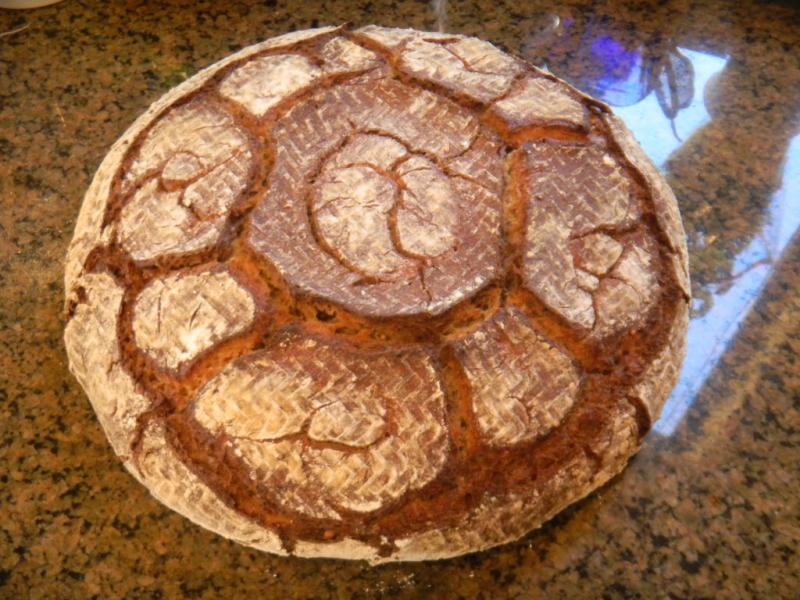
What was left over was two light ropes that were placed on the spread out remaining dark side. The long sides of the dark were folded over the light ropes to encapsulate them making a long rectangle. The shot sides of the rectangle were folded over to the middle making a near square where the corners were folded into the center making a circle that was quickly shaped as a boule.

This boule was pressed out gently into a large bialy with the center indentation equal in size to the circle of knotted rolls, ropes and balls already in the basket. The large bialy was floured around the edge that would contact the basket with rice flour and flipped over so the indentation covered the knotted rolls and the assembly was basically flat on top when finished.

We hope this assembly will make a very pleasing marbled look when the chacon is cut. Otherwise it was a waste of time and effort…something every baker is well used to if they have been baking more than a couple of minutes with an apprentice that is nearly all paws, bark and ankle bite.

The levains were formed by mixing, letting them double over about 4 hours or so and then chucking them in the fridge for 24 hours to build the labs while suppressing the yeast. The flours and toasted bits were autolysed with the liquids and the salt for 2 hours as the levains came back to room temperature a day later.

Once the autolye and the levain were combined for each, the gluten was developed with 15 minutes of French slap and folds. Then 4 sets of S&F’s wee done fpor each where the sprouts were incorporated on the 3rd set. The dough’s were allowed to develop for 1 ½ hours on the counter before being retarded in a36 F fridge for 15 hours.

They were allowed to warm up for 1 ½ hours before being formed into the chacon and the allowed to proof at room temperature for 2 hours before firing up old Betsy and her16”round stone, to preheat at 500 F for 20 minutes before 2 of Sylvia’s steaming pans were added.

After 45 minute of total pre-heat the chacon was un-molded easily from the basket using parchment and peel. It slid into the oven off the peel when a 1/2 C of water was thrown into the bottom of the oven for extra initial steam and the door closed. The temperature was turned down to 450 F the steaming was done at the 20 minute mark when the pans were removed and the temperature turned down to 425 F, convection this time.

In another 20 minutes the bread was exactly 205 F in the middle and beautifully and evenly brown from rotating it 90 degrees on the stone every 5 minutes after the steam came out. At the 40 minute total mark, we turned off the heat and left the oven door ajar as the chacon continued to crisp on the stone for another 10 minuets before removal to the cooling rack.
The chacon didn't spring all that much and might have been a little over proofed but it did bloom and crack as expected. It is a very pretty large chacon and we can’t wait for it to cool down and rest for awhile before we cut it .... and see if anything interesting happened inside.
Now that it is cut..... the light and dark did learn to play well together. We are pleased that it is so pretty on the inside and fitting for such a gorgeous outside. The crumb is fairly open for so many add ins and whole grains. The dark is tangy sour while the white is a little sweet, maybe sue to the Cake meal, has no tang and is a little moister as YW tends to impart in crumbs everywhere. A very nice combination of two tastes. The toasted bits tend to come through more on the dark side and the millet crunch is prevalent throughout. This bread will have to to to the top of the chacon list and into the top 15 of our all time top 5 favorites. I'm glad we made a big one.
Formula
Combo Starter | Build 1 | % |
SD Desem & Rye Sour | 30 | 3.01% |
Bulgar | 20 | 2.56% |
Dark Rye | 20 | 2.56% |
Kamut | 20 | 2.56% |
Buckwheat | 20 | 2.56% |
Spelt | 20 | 2.56% |
Whole Wheat | 20 | 2.56% |
Yeast Water | 60 | 7.69% |
Ground Flax | 20 | 2.56% |
Cake Meal | 80 | 10.26% |
Water | 140 | 17.95% |
Total Starter | 450 | 39.74% |
| | |
Starter Totals | | |
Hydration | 97.25% | |
Levain % of Total | 17.88% | |
| | |
Dough Flour | | % |
Whole Spelt | 25 | 3.21% |
Dark Rye | 25 | 3.21% |
Whole Wheat | 25 | 3.21% |
Whole Kamut | 25 | 3.21% |
Bulgar | 25 | 3.21% |
Buckwheat | 25 | 3.21% |
Cake Meal | 50 | 3.21% |
Oats | 20 | 2.56% |
Instant Potato Flakes | 20 | 2.56% |
Bread Flour | 245 | 31.41% |
AP | 245 | 31.41% |
Dough Flour | 730 | 93.59% |
| | |
Whey 125 and Water | 610 | 78.21% |
Dough Hydration | 83.56% | |
| | |
Total Flour | 998 | |
Total Water & Whey Water | 822 | |
T. Dough Hydration | 82.36% | |
Whole Grain % | 43.19% | |
| | |
Hydration w/ Adds | 78.94% | |
Total Weight | 2,517 | |
| | |
Add - Ins | | % |
Red Multi-grain Malt | 3 | 0.38% |
Barley Malt | 20 | 2.56% |
White Multi-grain Malt | 3 | 0.38% |
Total | 26 | 3.33% |
| | |
Multigrain Sprouts | | % |
WW | 25 | 3.21% |
Rye | 25 | 3.21% |
Quinoa | 25 | 3.21% |
Buckwheat | 25 | 3.21% |
Millet | 25 | 3.21% |
Bulgar | 25 | 3.21% |
Spelt | 25 | 3.21% |
Total Sprouts | 175 | 22.44% |
| | |
Toasted Bits | | % |
Toasted Germ, Oat Bran & Extraction | 50 | 6.41% |
10 g each of instant coffee and cocoa went into the dark side only.









